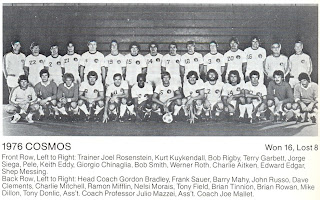But the hype was growing and NASL, if anything, was pouring more fuel. In 1975 Pele was signed and that was news made so big, other transfers were practically ignored – Eusebio and his Benfica and Portugal teammate Antonio Simoes also came to NASL in 1975. 1976 really opened the gates: George Best, Bobby Moore, Rodney Marsh arrived, to mention only the biggest names. They were all Fulham players – and remained so: in fact, they played for two clubs simultaneously (well, registered in two clubs in reality – probably the formal situation was described as ‘loan’).
George Best playing for Los Angeles Aztecs. He loved USA and stayed in NASL for years. For him, it was easy, anonymous, and relaxing life, dedicate to the bottle. His drinking buddies from Fulham – Marsh and Moore – faired well in NASL too… It was fun:
NASL loved and encouraged ‘reunion’ photos, like this friendly chat between Pele and Simoes, but a picture like this not only represents the relaxed North American football, but also questions strongly the true nature of the American brand. Was it serious at all? For anybody? In seriously competitive leagues players of opposite teams are never seen friendly together before the game or immediately after the final whistle.
Stars are stars, but overall the league was mediocre…
Pele vs Jose Soroa. Soroa was Uruguayan, but who was he? No wonder, old Pele still shined.
To which the American transfer policies contributed gravely as well: they were so loose, a player often appeared in few clubs in a singular season. Eusebio was like that, for instance – including a brief return to Portugal, where he still managed to play 12 matches for Beira Mar before the year ended.
Yet, with all media hype, North American football remained largely unknown: New York Cosmos was the only familiar club, thanks to the transfer of Pele. Of course, Cosmos was spending most money and even more in the future, when they seriously got all the big names of the 1970s, but Pele propelled them to fame outside North America.
Here they are in 1976. Having already Pele, Mifflin, and Nelsi Morais, Cosmos made new move – and quite unusual one too: they acquired the services of actual star, not some famous name on his last legs. Giorgio Chinaglia was bought from Lazio. Chinaglia was fed up with hostility in Italy; money were great, he moved. He was 29 years old, not exactly young, but still in his prime. Very likely not Pele, but Chinaglia was the greatest star of Cosmos – he played in New York for many years, and inspired his teammates no matter how famous, or anonymous. He contributed a lot: he arrived with a bang, becoming the top goalscorer of the 1976 NASL season.
Dreams coming true… Chinaglia and Pele. So many players dreamed to play along with the King, but for Chinaglia it became reality.
Well, Cosmos looked like sure champions with this squad.
They were not. The King of the world lost to the former King of European football.
Eusebio in attack, with teammate Wolfgang Suhnholz and Kick’s defender Sam Beck around. NASL teams sported weird kits as a rule, but Eusebio here is equipped with true to the sport and fashionable Adidas. No, it is not Benfica, but his current club Toronto Metros-Croatia. His arrival to North America in 1975 was almost anonymous, because of the noise Pele’s transfer made. But Eusebio won the NASL title in 1976 and Pele did not…
Here are the champions. One player was seemingly enough to win the championship – it looks like so, for the rest are entirely unknown. As the name suggests, the Canadian club had ethnic origins, well preserved in the making of the squad. The mystery, however, is who was Canadian player, even by naturalization, and who was foreign import: most players are clearly ethnic Croatians, but since not a single name rings any bell, they were recruited from the Croatian community in Toronto; not imported from Yugoslavia. The German Wolfgang Suhnholz was also likely naturalized Canadian and not Bundesliga import. Kapetanovic was voted NASL coach of the year, but he too seems naturalized Canadian. Most likely only Eusebio and Evair were ‘true’ imports. It looks like better work was done in Toronto than in New York and elsewhere: the squad is not rag-tag collection of player, but more carefully build from local guys. It was a team, to which Eusebio (who did not stay with Metros-Croatia after winning the title) added class and experience. The winners confirmed old truism: names do not win; teams do. Unfortunately, the increasing importation of foreigners by other clubs left no chance for these guys to repeat their success: they were really small fry. The policies of NASL discouraged team building and perhaps this was the biggest reason for collapse of the league: why trying to teach some Grnja play decent football if you can get Beckenbauer? Oh, well, New York Cosmos had to sulk in 1976 and Eusebio added one more title to his collection.








